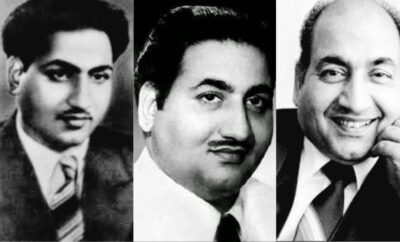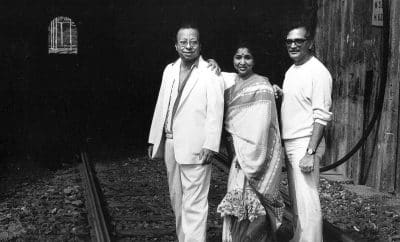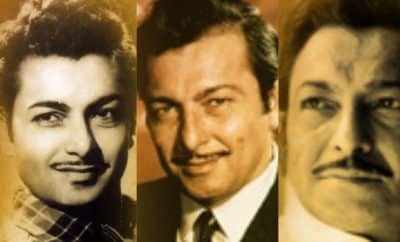Song Sketch
A Tale of Two Songs
Today I am going to talk about two songs which are uniquely connected with each other in more than one way. The first song is from 1965 released film, Aadhi Raat ke Baad. Mera Dil Baharoka wo phool hai, jise gulsitan ki nazar lag gayi. Music by Chtitragupt and beautifully sung by Lata Mangeshkar. The second song is from the 1972 released film, Amar Prem. Chingari Koi Bhadke Music by RD Burman and sung by the maverick artist, Kishore Kumar. The common factor between the two songs is, both are penned by the famed lyricist, Anand Bakshi. But for me, there is one more connection between the two songs. The lyrics and feelings expressed in both the songs are intertwined and are a reflection of each other. Both carry the same theme or message i.e., being cheated, deceived or betrayed by someone whom you trust the most or whom you least expect to do so and the pain of which is the hardest to bear with. This is possibly true with all of us too. The pain of betrayal hurts much more when the same is inflicted by someone “Koi Apna ”. Both these songs express that feeling extremely powerfully, through different sets of lyrics. In fact, I personally feel that the feelings expressed in Chingari Koi Bhadke are precursor to those of Mera dil baharon ka wo phool hai, even though, Chingari came later simply because, in Mera dil baharon ka the action of being betrayed by a dear one is already complete while Chingari talks about what would happen, if someone near and dear one actually betrays. In both the songs, Anand Bakshi Ji has used wonderful metaphors and analogies to amplify the point. For e.g. the second antara of Mera Dil says, mujhe is zamane ne luta nahi, ye dil badnasibi se tuta nahi, sitamgar (oppressor or tyrant) koi mujhse Rutha nahi, kisi meherban ki nazar lag gayi. And the 1st Antara of Chingari says, humse mat pucho kaise mandir toota sapno ka, logo ki baat nahi hai, ye kissa hai apno ka. Koi Dushman thess lagaye to meet jiya bahlaye, manmeet to ghaav lagaye, use kaun mitaye. Amazingly poignant thoughts, wonderfully captured in equally poignant and emotional lyrics.
Complete lyrics of both the songs, along with meanings of some of the uncommon words from these songs are given below. I am sure, the readers would be able to appreciate the point I am trying to make once you read and/or hear both the songs.
मेरा दिल बहारों का वो फूल है (Aadhi Raat Ke Baad 1965)
Mera dil baharo ka wo phool hai
mera dil baharo ka wo phool hai
jise gulsita (garden) ki nazar lag gayi
kisi ne jalaya nahi ye chaman (flower garden)
ise bagba (gardener) ki nazar lag gayi
Ye sach hai ke tumne mujhe gum diya
tumhe fir bhi maine na ruswa (disgraced) kiya
ye sach hai ke tumne mujhe gum diya
tumhe fir bhi maine na ruswa kiya
kisi ne jo pucha to ye kah diya
mujhe aasma ki nazar lag gayi
mera dil baharo ka wo phul hai
jise gulsita ki nazar lag gayi
Mujhe is zamane ne luta nahi
ye dil badnasibi se tuta nahi
mujhe is zamane ne luta nahi
ye dil badnasibi se tuta nahi
sitamgar (tyrant or oppressor) koi mujhse rutha nahi
kisi meharban (kind hearted person) ki nazar lag gayi
mera dil baharo ka wo phool hai
jise gulsita ki nazar lag gayi
Nazar muskurai thi jiske liye
usi ne nigaho ko aasu diye
nazar muskurai thi jiske liye
usi ne nigaho ko aasu diye
jaha dil diwane ne sajde (prayers) kiye
usi aasta (trust or faith) ki nazar lag gayi
mera dil baharo ka wo phool hai
jise gulsita ki nazar lag gayi
चिंगारी कोई भड़के (Amar Prem 1972)
Chingari koi bhadke
chingari koi bhadke, to sawan use bujhaye
saavan jo agan lagaaye, use kaun bujhaye
ho use kaun bujhaye
patjhad (autumn) jo baag ujaade, vo baag bahaar (spring) khilaye
jo baag bahaar mein ujade, use kaun khilaaye
ho, use kaun khilaaye
Humse mat poochho kaise, mandir toota sapno ka
humse mat poochho kaise, mandir toota sapno ka
logo ki baat nahi hai, ye kissa hai apno ka
koi dushman thes lagaaye, to meet jiyaa behlaaye
manmeet jo ghaav lagaaye, use kaun mitaaye
Na jaane kya ho jaata, jaane hum kyaa kar jaate
na jaane kya ho jaata, jaane hum kyaa kar jaate
peete hai to zinda hai, na peete to mar jaate
duniya jo pyaasa rakhe, to madira pyaas bujhaaye
madira jo pyaas lagaaye, use kaun bujhaaye
ho use kaun bujhaaye
Maana toofan ke aage, nahi chaltaa zor kisi kaa
maana toofan ke aage, nahi chaltaa zor kisi kaa
maujon (waves of sea) kaa dosh nahi hai, ye dosh hai aur kisi ka
majdhaar (vortex/whirlpool) me naiyaa dole, to maajhi paar lagaaye
maajhi jo naav duboye, use kaun bachaaye
ho use kaun bachaaye, chingaari
https://www.youtube.com/watch?v=LXElgWEgSgw
The first song of Aadhi Raat ke Baad has magnificent piano accompaniment, possibly played by Robert Correa, in the prelude and interludes, alongwith bongo beats. The antaras have lovely soft tabla in the background. But the real melody of this song comes from the honeysweet voice of Lataji. I always felt that Lataji had extra sweetness in her voice for Chitragupt, apart from of course, for Madan Mohan. The song is picturised on Ragini, one of the three famed Travancore Sisters, the other two being, Lalitha and Padmini. Lead actor was Sailesh Kumar whose real name was Shambhunath Purohit. He was also seen later in movies like, Kalicharan and Charas,
Chingari is certainly considered as one of the signature creations of the trio of RD, Kishore Kumar and Rajesh Khanna. However, the contribution of Anand Bakshi, whose lyrics have lent so much power to the song, cannot be overemphasised. The opening piece of Guitar was played by famous guitarist and lovely singer, Bhupinder Singh which is certainly the hallmark of this wonderful composition, alongwith mind-blowing flute pieces, played by another maestro, Hariprasad Chaurasia. Added to those are, marvellous tabla and reso reso beats throughout the song. The calm and serene atmosphere of Hooghly river by the night is wonderfully complemented by muted yet expressive emotions of Sharmila Tagore and contagious nonchalance of Rajesh Khanna, (either caused by the spirit he is holding in his hand or by the spirituous waters of Hooghly or possibly both), which is superbly brought out by Kishore Kumar, as only he could. All these factors have combined beautifully to make this song an unforgettable and exhilarating audio-visual experience.




Joy Christie
May 29, 2021 at 7:25 am
Both the songs very well detailed lyrically and musically. A very superb findings of the similarities of both the songs in the writing of the songs of Anand Bakshi.
Chitragupt was a music director par excellence with a clear vision. He being the assistant of S. N. Tripathi ji had very well understood the film music score. The importance of melody. While there were many big proven brands in music but Chitragupt was unique.
The antraas are really very tough to sing superb compositions and his music patterns are unique. The tonal effect and sharpness of his songs is superb much more better than the others of that time.
RDB in Amar Prem did fantastic job. I think he has just used the Khamaj only single raaga for all songs of Amar Prem what a thought and vision. Bhupi ji” s 12 strings guitar resembles the boat shaking left and right
Basu Da was a genius n arrangements of strings unlike a 60/70 violins he used just a small set of strings.
Kishore Kumar only can justify these types of songs.
Shyam Anikhindi
May 29, 2021 at 1:26 pm
Excellent